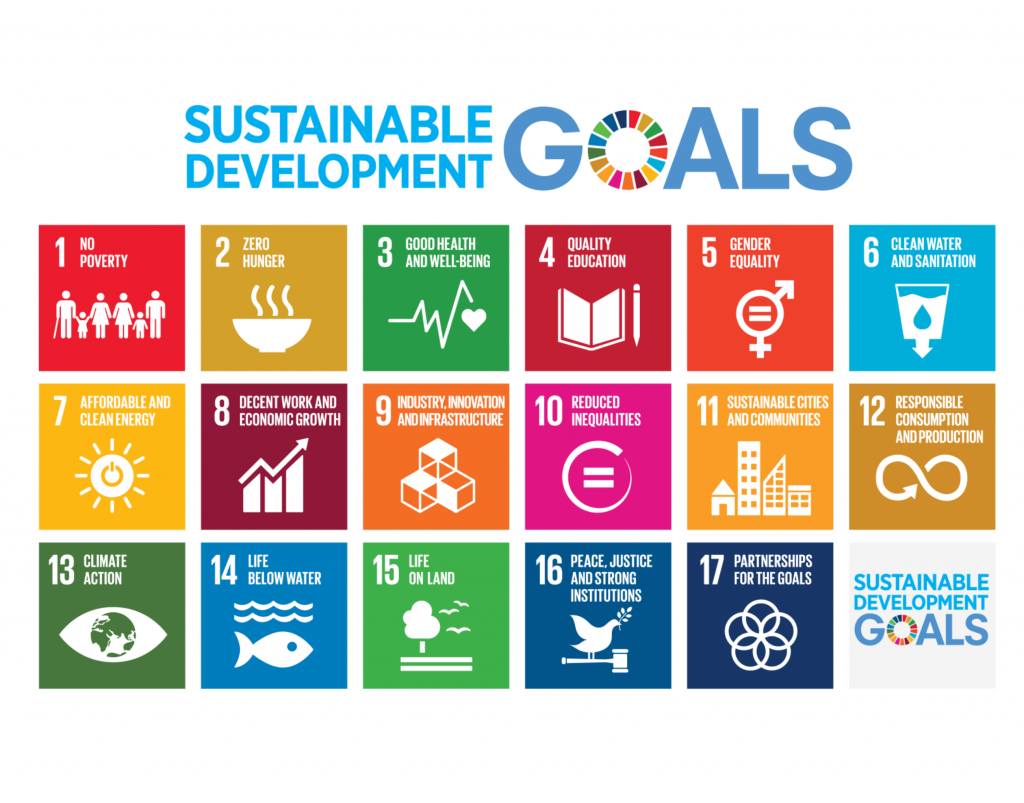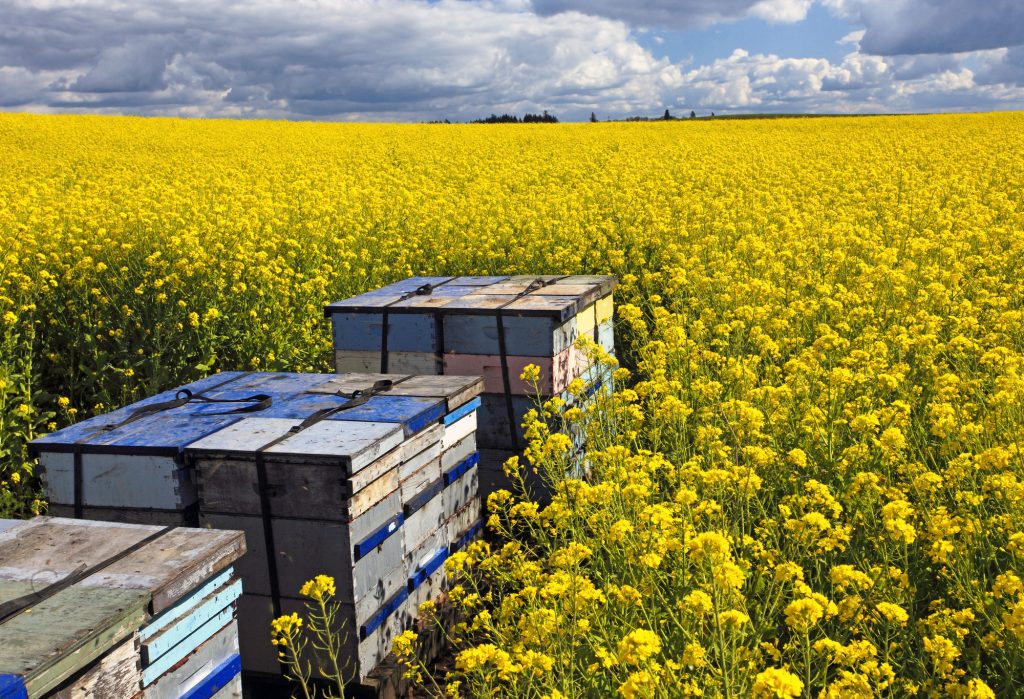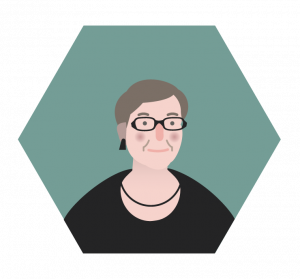16 On The Map
Mapping the U.N. Sustainable Development Goals to Learning Outcomes
By Jenni Hayman, eCampusOntario
There are 17 United Nations Sustainable Development Goals (or SDGs for short). As pictured above, they include complex global outcomes such as “No Poverty,” “Zero Hunger,” “Good Health and Well-Being,” “Quality Education,” etc. No one goal is more important than the others, and all need to be explored to help ensure a path toward increased global equity. I would even venture to say that our human survival depends on our ability to achieve these goals. In the background of each goal, if you explore them more on the SDG 2030 website, are sub-goals defined by the U.N. that might be useful as part of curriculum design. They are starting places only, but they’ve been deeply considered.

While the SDGs are grounded in extraordinarily complex problems that might seem out of reach for any one learner, educator, or course, I believe that if we begin to pool our imaginations and collective research projects, we can start to make a dent. What does use of the SDGs look like at a the unit level? What might use of SDGs look like for a course, program, degree, institution, province, or nation? The answers to these questions are up to us as a global community of humans. I have some ideas for education starting places if they might be helpful.
In March 2017, at the Open Education Global Conference in Cape Town, South Africa, I had the privilege to test some of my pedagogic ideas around this concept with a group of peer graduate learners and conference attendees. The basis for my lesson plan was Biology 100 at the first-year undergraduate level. In North America, this is often a highly enrolled course delivered annually for thousands of learners. I felt it was a good place to start for an open, learner-driven plot to transform education. The discipline was not as important as the process of learner-driven design, grounded in curated, open educational resources for content, featuring locally contextualized SDGs. To help set the stage for a very short-term experiment, the SDG I selected for the course was “Life on Land” (number 15 in the SDG series). In my real-world course, I would invite learners to select SDGs for themselves.
Attempting to localize “Life on Land” to Cape Town, I did a scan of issues related to endangered species and came across the story of the Cape Honey Bee. While many bee populations at a global level are in danger, the Cape Honey Bee had recently suffered a 40% drop in population due to a nasty infestation of American Foulbrood Disease. The question I posed for the learners for this make-believe Biology unit was “what are three effective strategies that local advocates might implement to support the recovery of the Cape Honey Bee population?” Using a series of open educational resources, beginning with Wikipedia, learners were asked to go and find local, current, and relevant information about the physiology of the bee, the types of flowers that it relied on as food, and related information about local beekeepers, local bee-related agriculture, and other possible economic issues. In order to make the learning fun, I threw in a micro-unit on deciphering and recreating the “honey bee dance,” a particular form of communication that honey bees engage in to direct its colleagues to local flowers. It wasn’t strictly necessary, but I thought it might be fun.

Learners were asked to work in groups on one task at a time. One group was tasked with finding relevant information on bee anatomy and physiology, one on American Foulbrood Disease, one on the local Cape Town bee economy, and one on the honey bee dance. I ended up with one very dedicated group (related to conference attendee workshop choices) that worked on most of the tasks in pairs, then reported some findings about potential strategies. As a large group, the learners were tasked with agreeing on the three most important strategies in their view. Keeping in mind that I only had two hours for this in a face-to-face action lab, some adjustments would be required for the design of a full course that might include the learning strategies. My learners might also be online (always much harder to manage and support in terms of group work).
My Cape Town learners were unusually tech-savvy related to quickly finding digital resources for their learning, and also possessed significant knowledge of copyright and OER. They were highly successful even in a very short learning moment. A successful deployment of my learning design in the real world would require (in my view) some preliminary support modules such as Discernment (finding accurate and reliable sources of information); Copyright (finding open educational resources where the license grants permission to download, adapt, and share); Adaptation (different OER file types and open tools that can be used to adapt them); and finally, but certainly not least, Inclusive Design (ensuring that all adapted and shared OER were designed with diverse learner abilities in mind). These might be necessary, or at least important to have at hand, for an unpredictable group of new learners. I believe these modules would empower learner-driven content curation toward collaborative problem-solving. Conveniently, there are already such modules in the OER spectrum; I would just need to curate them and ensure they were adaptable by other educators and learners to suit their contexts.

“Where does the full Biology 100 course fit in related to this isolated example?” you might well ask. Well, there is the possibility of using the OpenStax Biology open textbook as one content basis for the course. This would be used as a “one among many” choice, and permission and encouragement for learners to adapt it for themselves would be extended. Certainly learners would be encouraged to adapt it to their local context. The development of shadow modules, collaboratively designed study tools, and study questions that help all learners in the course get the core knowledge of general Biology under their belts might also be encouraged. Long ago and far away in old-timey education, this might have been called cheating. In my world I call it raising the collective boat (in my head I said the “damn collective boat” but I try not to curse too much when writing for a wide audience).
Imagine a semester or two of this learner-driven design, where learners decide which of the SDGs to focus on for the chapters of the book, and for each chapter’s assessment they would submit group-designed strategies that might work in their local context. Imagine if group work was a choice, rather than a requirement, and learners that preferred to work individually were allowed to do that, and join in the collective decision-making about strategies. Imagine if learners went out into their local communities to find experts in the SDG problems they selected, if they conducted local experiments and research related to the SDGs, if they tried one or two of their strategies, and kept reporting back to the full class. Imagine if they used their personal domain to blog about their citizen science, shared their resources publicly, and submitted homework and final assessments that were shared with local SDG advocates and community groups. Imagine if Biology instructors in regions, provinces, and nations connected their learners to each other. That’s a lot of collective boat-raising.
I hope you can see where I’m driving with this. What I’m proposing here is not some type of ed-tech solution, just good old-fashioned hard work with extraordinary real-world magnification. What might your course look like using the method I’ve described and any one, or all, or some of the SDGs? We all have to start somewhere; it can be small or large. A moment in a course, in a sea of courses. If you want to talk it over with me as I continue my own experiments, I’d love to!
@jennihayman and jhayman@ecampusontario.ca

image credit: “Must Bee Heaven” flickr photo by Ian Sane https://flickr.com/photos/31246066@N04/34369197611 shared under a Creative Commons (BY) license


